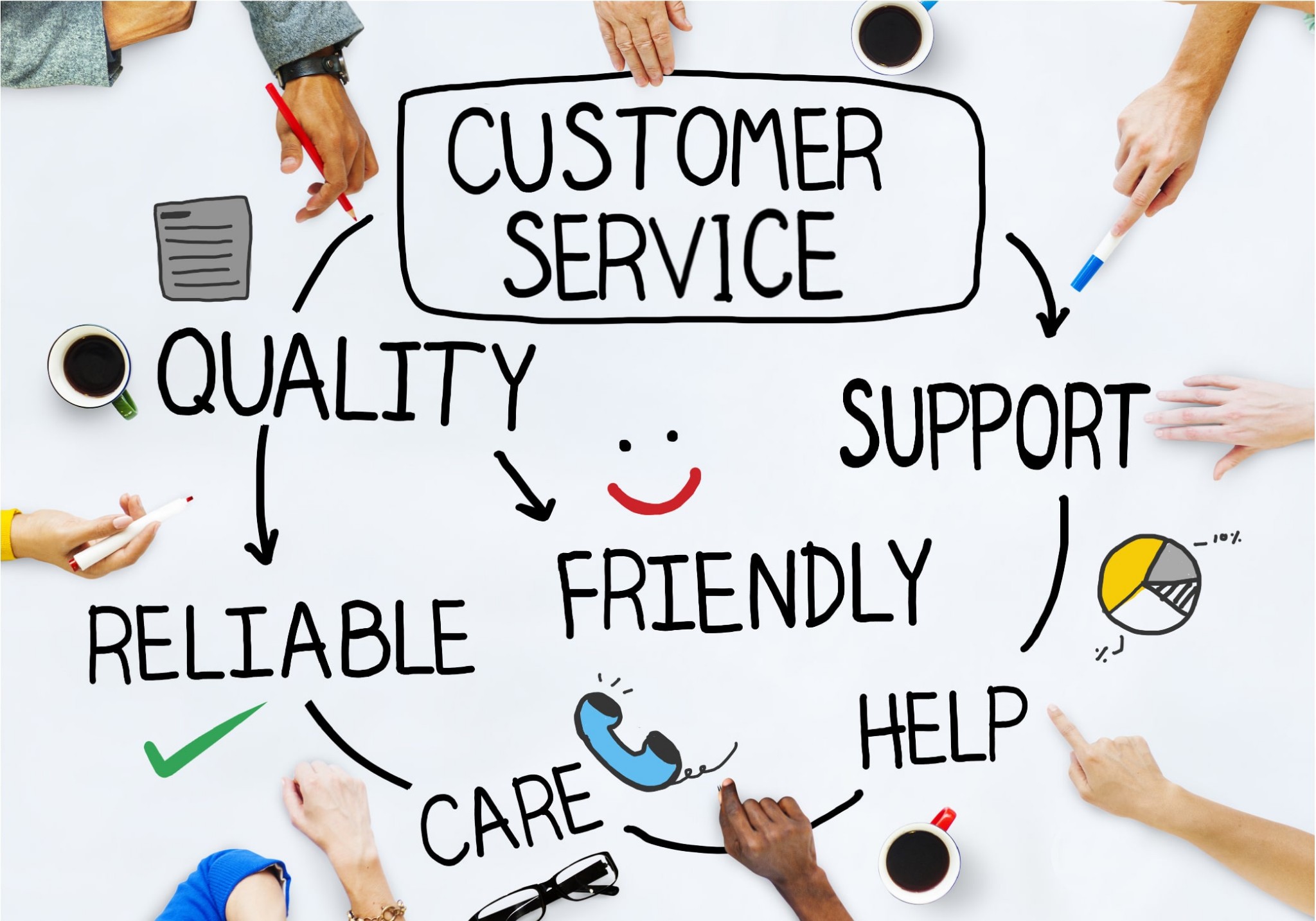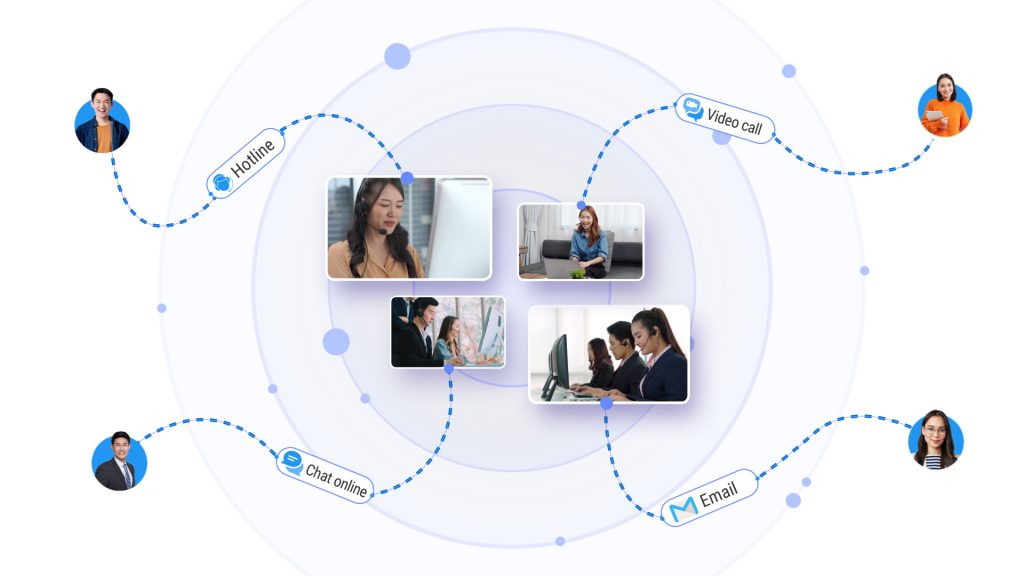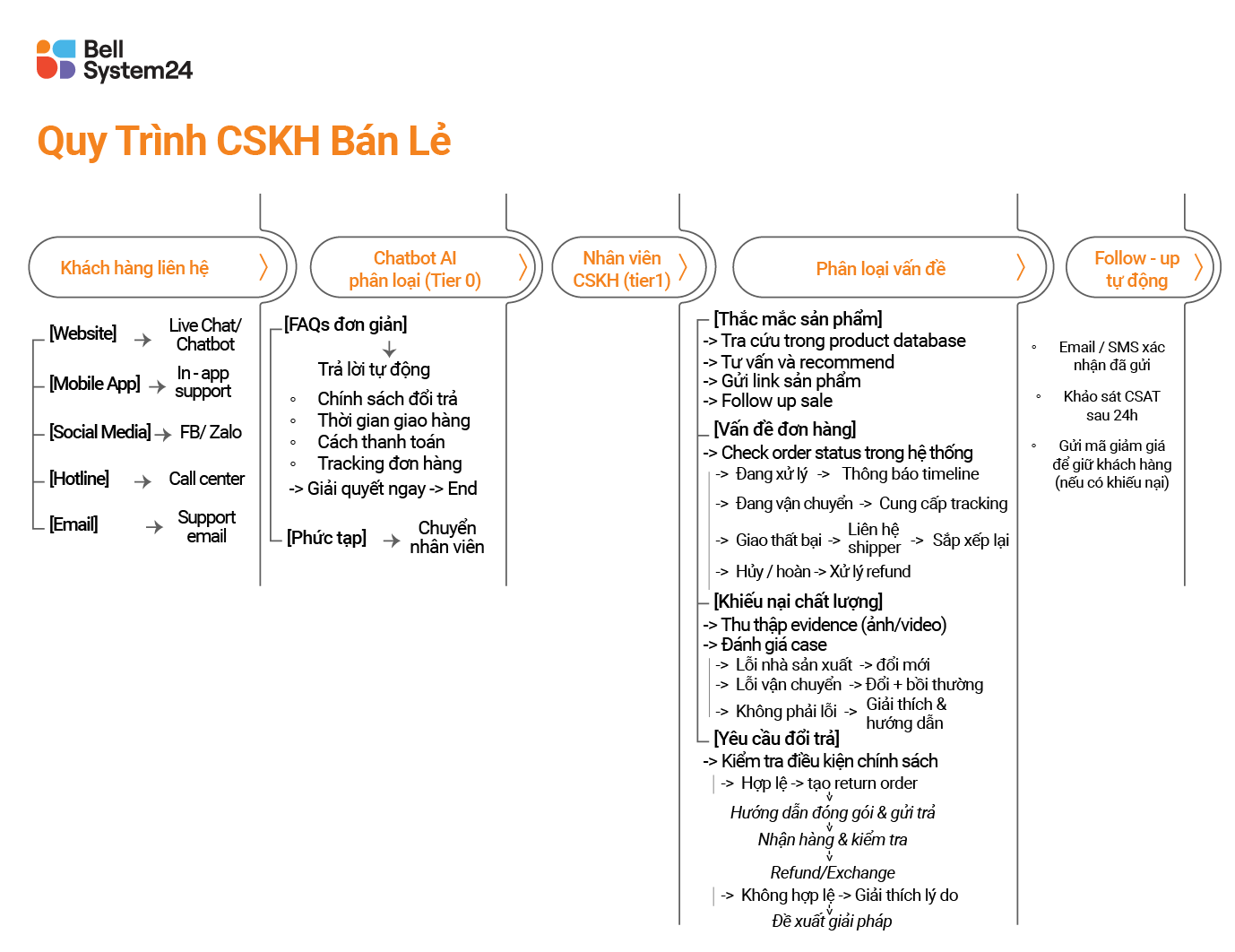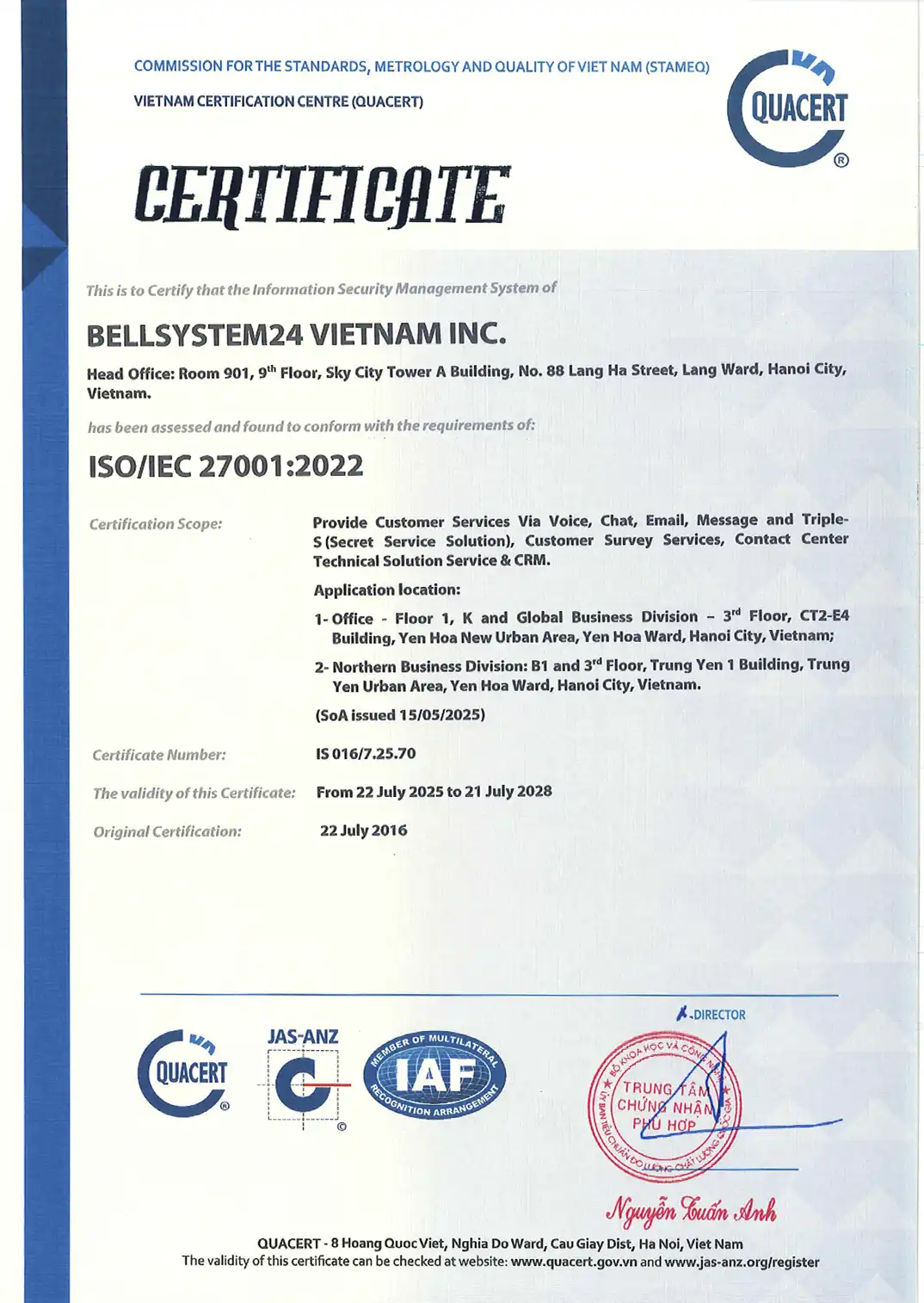For a business to increase its competitiveness, it is essential to have an appropriate customer care strategy. The following article will provide an overview of customer care and effective implementation methods.
What is customer care?
Customer Care is a business activity, implemented to meet the needs and expectations of customers, thereby helping to increase customer trust and loyalty to the brand.
Customer care activities take place throughout the entire process. before – during – after sales.
Each business will have its own specific customer care approach depending on its products and customer characteristics. Call center agents will be the ones who interact with customers to monitor service usage, receive feedback, record information, and resolve any issues that arise.
Some common customer service activities:

Customer care helps retain existing customers and increase revenue through repeat purchases. It can be said that this is an essential part of any business.
What is effective customer care?
Effective customer care is the implementation of a deliberate strategy to meet customer expectations, align with brand promises, and achieve core business objectives (such as satisfaction, loyalty, revenue, and profit).
"Effectiveness" is not a fixed standard, but rather the intersection of two factors:
- Core Principles: What needs to be done.
- Strategic Context: Method and extent of implementation.
1. Core principles
These are the universal foundations upon which all effective customer service strategies are built, albeit to varying degrees:
- Empathy: The ability to understand and share customers' emotions. This is the foundation of all positive interactions.
- Speed & Efficiency: Respect your customers' time. Resolve issues quickly and ideally during the first interaction.First-Contact Resolution).
- Transparency & Reliability: Keep your promises. If there is a problem, communicate clearly and honestly.
- Personalization (Personalization): Make customers feel like they are treated as unique individuals.
- Convenience & Accessibility: Provide support through the channels that customers prefer (Omnichannel) and makes communication easier.
- Proactiveness: Problem solving before customers recognize or complain.
2. Strategic Context
This is what makes the difference. Every business has different goals and contexts, so an effective customer service strategy must be tailored to the specific characteristics of that business. Below are the strategic contexts.
2.1 Brand Positioning
- Premium brand: Prioritize personalization and empathy. They accept higher customer service costs to deliver a "wow" experience that exceeds expectations. At that point, the Effectiveness = Customers feel special.
- Budget brand: They will prioritize speed and efficiency. They don't promise a "wow" experience; they promise to solve problems quickly and cheaply. At that time,Effectiveness = The problem is solved at the lowest cost.
2.2 Business Model
- B2C (Retail, E-commerce): Handling massive amounts of interactions.
- Effective strategy: Prioritize response speed (short wait times) and omnichannel consistency. They use technology (CRM, AI Chatbot) to manage scale.
- B2B (SaaS Software, Services): High contract value, long-term relationship.
- Effective strategy: Prioritize deep expertise and proactivity. Customers are willing to wait longer to speak directly with a specialist (Technical Account) who can resolve the root cause of the issue, rather than a call center agent reading from a script.
2. 3. Customer Segment
- Gen Z audience: The convenience of chatting via Zalo/Messenger and self-service channels can be highly appreciated.
- Older adults: You may prefer the reliability of calling directly and speaking with a real person.
- VIP Customers: A dedicated support channel (dedicated hotline, dedicated account manager) is needed to match the value they bring.
Effective customer care is not about trying to do all six core principles at once, but rather making smart choices:
- Understand What your customers want.
- Know What is your brand promise?
- Allocation resources (people, technology, money) to implement the principles excellently most important with that customer segment and brand promise.
At Bellsystem24 Vietnam, we have implemented a contact center customer service solution for our partner, a ride-hailing app, with the goal of meeting the diverse needs of various groups (customers, drivers, restaurant owners). Each group has its own specific requirements, so we have divided the project into several different teams with corresponding skills to serve each specific group.
See also: The project achieved an SLA of 99% in the field of customer care.
Levels of customer care

- Level of service crime evil: This is a service that customers never want to use again or resort to a more uncontrollable behavior than boycotting. Because the emotion they feel is frustration and discomfort.
- Basic service level: The company provides services below expectations. Therefore, customers feel disappointed, leading to a decision not to use the service again.
- Average service level: The company provides acceptable services, but they are still below expectations. Customers can still continue using them because there are no better alternatives or substitutes.
- Expected service level: Service quality meets the requirements and criteria set by customers. Their feelings are normal, as this is the default quality that businesses must achieve. Customers will return to use the service again.
- Unexpected service level: Delivering service quality that meets customer expectations, while offering unique features that delight customers. Customers will return to use the service repeatedly.
- Unbelievable service level: This is the highest level. Customers receive an experience that exceeds their expectations, is highly surprising, and even makes them think that the business would never do this for them. Customers will feel amazing, perhaps even saying "WOW," and they will never forget the brand. They will also spread the word about this experience to many people.
Customer's desire

Customer service skills
Please see the full article here: Excellent customer service skills
Key factors when implementing customer service

Increase customer engagement
Ensure that customers can always interact easily with the business. Businesses need to create channels to reach and record customer information more easily. Example: Some businesses create groups on Facebook or Zalo to facilitate communication, provide customer care, and answer all customer inquiries..
The trend that every business is moving towards is Integrated multi-channel customer care (Omni-Channel) – Multi-channel interaction solutions and data storage based on customer journeys.
Receive and process feedback quickly
Speed and attitude are very important. Every customer service representative will be trained in knowledge and customer service skills Before starting work. In addition, businesses also need to allocate personnel appropriately to ensure customers always receive support, provide automation solutions and smart search tools to help call center agents increase customer response efficiency.
Coordinate smoothly with other departments
The customer service department needs to coordinate with other departments (Sales, Marketing, Administration) to facilitate communication on relevant issues during the customer support process. In addition, it can propose business plans, service improvements, and product enhancements, or coordinate with the Marketing department to implement simultaneous customer care campaigns across multiple channels.
Develop a plan for regular customer care
Regularly take care of customers, closely follow the company's and department's plans and directions. Pay attention to special occasions of customers to increase satisfaction.
Customer service quality indicators
Customer service department needs to pay attention and measure the following indicators:
- Customer Satisfaction (CSAT): Customer satisfaction measurement index.
- Net Promoter Score (NPS): Net Promoter ScoreMeasure customer satisfaction and the likelihood of customers recommending the product.
- Customer Retention Rate (CRR): Customer retention rate
- Customer Lifetime Value (CLV): Customer Lifetime Value
- Customer Engagement (CE): Customer engagement index
- Customer Complaints: Customer complaint rate
- Conversion Rate: Customer conversion rate.
- Service level: Service quality index.
See details: 10 Customer Experience Metrics
Effective forms of customer care

Customer care via voice channel
Using voice channels is a method that never goes out of style. With the advantages of being fast, accessible, and highly effective, it is suitable for most businesses. Especially now with the strong support of the system. Call centerCustomer service will be better than ever.
Customer service via social networking sites
We have clearly seen the explosion of social media over the past decade, so customer service via social media is gradually becoming a trend. Customers can quickly get answers to their questions and complaints.
Use Live Chat on the Website, App
According to a report by Microsoft about customer service, there is 64% Customers often use livechat to find out information about products or contact for direct consultation. Online chat will be responded to quickly without having to dial a phone number.
Customer Service via Email
Email remains an effective channel in today's workplace. Although response times are longer than other channels, it offers a high degree of reliability and accuracy. This is a format chosen by many businesses, especially B2B companies.
Direct customer service
Customer service at the point of sale or at home often provides the best customer experience among solutions because employees have the opportunity to interact directly with customers. It is often implemented by large enterprises with highly complex products and services.
Some standard interaction patterns in Customer Care
Bellsystem24 Vietnam Please allow me to share some standard phrases used in customer service so that you can flexibly apply them.
Scenario 1: Open with the first greeting
"Hello, I'm calling to introduce our company's customer service offerings. We currently have several new promotions available for you."
Scenario 2: Honest Talk
Use sincere sentences, avoid bothering the customer: “Yes, I know you may be busy. But this call will only take less than 2 minutes, and I have some interesting information to share with you right away…”.
Scenario 3: When the customer has no need yet
Even when customers do not have a need for the product, customer service staff still need to create an impression for customers to remember your business.
“Yes, thank you, in case you are busy, we will call you back later. We look forward to working with you soon. Vietnam wishes you a good day?”
Prominent customer service trends in the next 10 years
Proactive customer support trend
A study by SocialIntents shows that 87% customers say they appreciate it when businesses proactively offer solutions before they even have a chance to ask. This "proactive" trend not only reduces frustration but also significantly increases customer satisfaction and loyalty to the brand.
Omnichannel consistency
Cross-channel experiences continue to prove their crucial role in the shopping journey. Research by UniformMarket shows that 73% retail consumers typically use at least 6 different touchpoints before making a decision. When implementing the Omnichannel model, many businesses report outstanding results: customer retention rates increase by 89%, purchase rates increase by 287%, and revenue from multi-experience channels accounts for up to 40.4% of total e-commerce revenue. Additionally, the order completion rate improved by approximately 251%, while the average order value increased by about 101% due to the seamless experience across channels.

Smart self-service portal
Smart self-service portals are also becoming a preferred choice. Smart self-service portals are also becoming a preferred choice. A Zendesk survey shows that 67% of customers prefer to resolve issues themselves rather than calling the call center, and 81% often start their support journey with self-service tools. The benefits for businesses are clear: service costs can be reduced by 30–40%, and some large financial institutions report savings of up to $5.4 million per year by implementing this system.
Hyper-personalized AI
Hyper-personalized AI is becoming the new "cornerstone" of the customer experience. According to The Future of Commerce report, nearly 80% customer service organizations plan to implement Generative AI by 2025 to boost efficiency and enhance service quality. Meanwhile, 50% businesses are prioritizing investments in personalization and customer data mining, while 44% are focusing on data integration and analysis to realize their strategy of enhancing the customer experience.
Outsource full-service customer care.
Bellsystem24 Vietnam is the leading unit in Vietnam in the implementation of outsource customer service, with experience operating call centers for over 200 reputable businesses in Vietnam and around the worldContact us now for professional customer care solution consultation.









